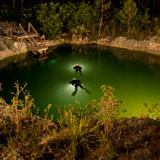Bahamas Caves in National Geographic
 Dis my Bahamaland. I tell you dat.
Dis my Bahamaland. I tell you dat.
Offshore flooded caves, so-called ocean blue holes, are extensions of the sea, subject to the same heavy tides and host to many of the same species found in the surrounding waters. Inland blue holes, however, are unlike any other environment on Earth, thanks largely to their geology and water chemistry. In these flooded caves, such as Stargate on Andros Island, the reduced tidal flow results in a sharp stratification of water chemistry. A thin lens of fresh water—supplied by rainfall—lies atop a denser layer of salt water. The freshwater lens acts as a lid, isolating the salt water from atmospheric oxygen and inhibiting bacteria from causing organic matter to decay.
Read more here: Bahamas Caves - National Geographic Magazine.
Kudos to Dr Tinker, Michael Pateman, and all the others at the National Museum, my former colleagues. Hats off. Keep up the good work.
